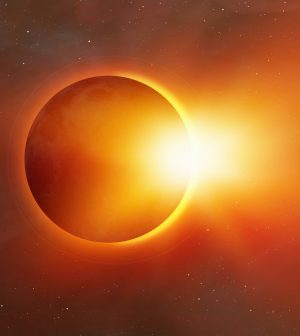- Navigating Your Midlife Crisis: Embracing New Possibilities
- City Raccoons Showing Signs of Domestication
- Mapping the Exposome: Science Broadens Focus to Environmental Disease Triggers
- One Week Less on Social Media Linked to Better Mental Health
- Your Brain Changes in Stages as You Age, Study Finds
- Some Suicide Victims Show No Typical Warning Signs, Study Finds
- ByHeart Formula Faces Lawsuits After Babies Sickened With Botulism
- Switch to Vegan Diet Could Cut Your Greenhouse Gas Emissions in Half
- Regular Bedtime Does Wonders for Blood Pressure
- Dining Alone Could Mean Worse Nutrition for Seniors
Watching the Solar Eclipse, Safely

Today is your last chance until 2044 to see a total eclipse of the sun in the continental United States.
But be sure to protect your eyes if you plan to watch the moon block the sun’s rays, briefly plunging Earth into temporary darkness.
“The eclipse will last a few minutes,” said Dr. David Hinkle, who chairs the Department of Opthalmology at Tulane University School of Medicine in New Orleans. “Eye damage can last a lifetime.”
There is no time — none at all — when it’s safe to look at the eclipse without proper eye protection, he emphasized. That’s true whether you are in the path of totality or in a broader swath of the nation where the sun will only be partially blocked.
Thirteen states from Texas to Maine are in the path of totality. Starting shortly after 1 p.m. Eastern time (ET), the moon will completely block the sun for one to four minutes.
Looking directly at the sun is never a good idea. It can burn your retina, Hinkle warned.
“The sun’s rays are powerful and can burn your retina very quickly,” Hinkle said in a Tulane news release.
That’s because the eye’s cornea and lens focuses the sun’s light directly onto this thin layer of tissue inside the back of eye, causing a burn called solar retinopathy. This damage, which may affect both eyes, can be permanent, causing legal blindness.
Hinkle offered advice on protecting your eyes while watching the rare celestial event:
-
Wear the right eye protection: Even if they’re heavily polarized, everyday sunglasses won’t protect you during the eclipse. You need eclipse glasses with the ISO 12312-2 filter, which blocks out 99% or more of the light. Anything that lets enough light in so that you can see through or walk around is not safe, Hinkle said.
-
Use a pinhole viewer: This is a homemade device that can project the eclipse onto the ground. Visit NASA for instructions to make your own.
-
Watch it online: NASA will show the eclipse in real time during a livestream on its website, starting at 1 p.m. ET.
-
Filter your camera: If you plan to photograph the event, make sure any cameras, binoculars or telescopes you may use are fitted with a solar filter. Massachusetts Institute of Technology has the information you need.
NASA also has an online guide with advice on where and when to watch the eclipse and how to do so safely.
More information
Learn more about eclipses of the sun and moon at the National Weather Service.
SOURCE: Tulane University, news release, April 3, 2024
Source: HealthDay
Copyright © 2025 HealthDay. All rights reserved.










